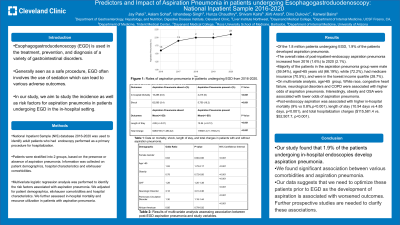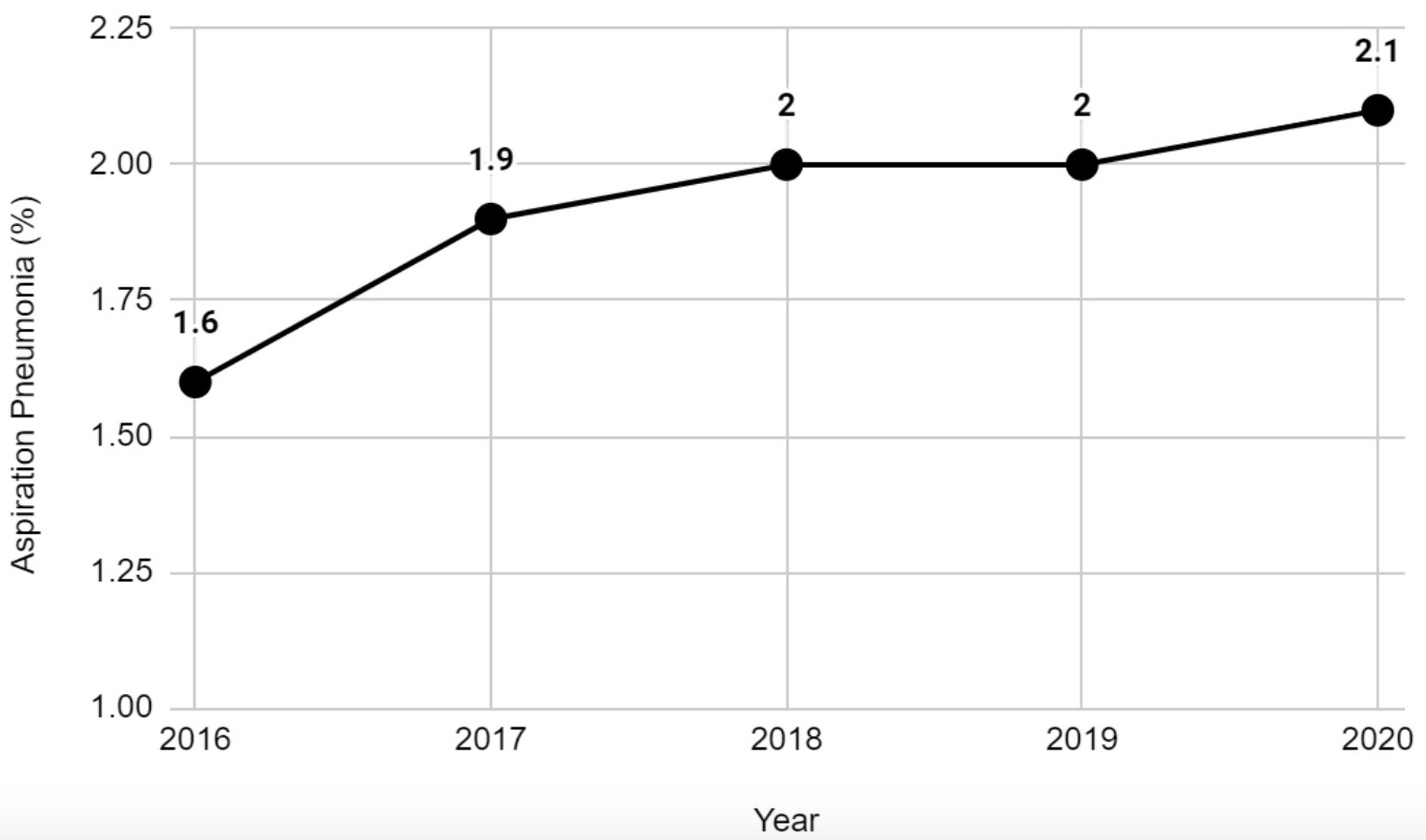Sunday Poster Session
Category: General Endoscopy
P0552 - Predictors and Impact of Aspiration Pneumonia in Patients Undergoing Esophagogastroduodenoscopy: National Inpatient Sample 2016-2020
Sunday, October 22, 2023
3:30 PM - 7:00 PM PT
Location: Exhibit Hall

Has Audio
- JP
Jay Patel, MD
Orange Park Medical Center
Cleveland, OH
Presenting Author(s)
Award: Presidential Poster Award
Jay Patel, MD1, Aalam Sohal, MD2, Ishandeep Singh, MBBS3, Hunza Chaudhry, MD4, Shivam Kalra, MBBS5, Kirti Arora, MBBS3, Dino Dukovic, BS6, Kanwal Bains, MBBS, CNSC7
1Orange Park Medical Center, Jacksonville, FL; 2Liver Institute Northwest, Seattle, WA; 3Dayanand Medical College and Hospital, Ludhiana, Punjab, India; 4University of California San Francisco, Fresno, CA; 5Trident Medical Center, Charleston, SC; 6Ross University School of Medicine, Maramar, FL; 7University of Arizona, Tucson, AZ
Introduction: Esophagogastroduodenoscopy(EGD) is used in the treatment, prevention, and diagnosis of a variety of gastrointestinal disorders. Generally seen as a safe procedure, EGD often involves the use of sedation which can lead to various adverse outcomes. Aspiration pneumonia is a rare but feared complication in patients undergoing endoscopy. Till now, no nationwide studies have assessed the incidence as well as risk factors for aspiration pneumonia in patients undergoing EGD in the in-hospital setting.
Methods: National Inpatient Sample(NIS) database 2016-2020 was used to identify adult patients who had EGD performed as a primary procedure for hospitalization. Patients with missing demographics or mortality were excluded from the analysis. Patients were stratified into 2 groups based on the presence or absence of aspiration pneumonia. Information was collected on patient demographics, hospital characteristics, and elixhauser comorbidities. The rates of aspiration pneumonia were assessed every year. Multivariate logistic regression analysis was performed to identify the risk factors associated with aspiration pneumonia. We further assessed in-hospital mortality and resource utilization in patients with aspiration pneumonia.
Results: Of the 1.8 million patients undergoing EGD, 1.9% of the patients developed aspiration pneumonia. The overall rates of post-inpatient-endoscopy aspiration pneumonia increased from 2016(1.6%) to 2020(2.1%)(Figure 1). Majority of the patients in the aspiration pneumonia group were male(59.54%), aged >65 years old(66.19%), White(72.2%), had medicare insurance(70.5%), and were in the lowest income quartile(28.7%). On multivariate analysis, age >65 group, White race, CHF, neurological disorders and COPD were associated with higher odds of aspiration pneumonia(Table 1). Interestingly, obesity and OSA were associated with lower odds of aspiration pneumonia. Post-endoscopy aspiration was associated with higher in-hospital mortality(9% vs 0.8%,p< 0.001), longer length of stay(10.54 days vs 4.85 days, p< 0.001), and increased total hospitalization charges($115,581.4 vs. $52,507.7, p< 0.001).
Discussion: Our study found that rates of post-EGD aspiration pneumonia are increasing. We found significant association between various comorbidities and aspiration pneumonia. Our data suggests that we need to optimize these patients prior to EGD as the development of aspiration is associated with worsened outcomes. Further prospective studies are needed to clarify these associations.

Disclosures:
Jay Patel, MD1, Aalam Sohal, MD2, Ishandeep Singh, MBBS3, Hunza Chaudhry, MD4, Shivam Kalra, MBBS5, Kirti Arora, MBBS3, Dino Dukovic, BS6, Kanwal Bains, MBBS, CNSC7. P0552 - Predictors and Impact of Aspiration Pneumonia in Patients Undergoing Esophagogastroduodenoscopy: National Inpatient Sample 2016-2020, ACG 2023 Annual Scientific Meeting Abstracts. Vancouver, BC, Canada: American College of Gastroenterology.
Jay Patel, MD1, Aalam Sohal, MD2, Ishandeep Singh, MBBS3, Hunza Chaudhry, MD4, Shivam Kalra, MBBS5, Kirti Arora, MBBS3, Dino Dukovic, BS6, Kanwal Bains, MBBS, CNSC7
1Orange Park Medical Center, Jacksonville, FL; 2Liver Institute Northwest, Seattle, WA; 3Dayanand Medical College and Hospital, Ludhiana, Punjab, India; 4University of California San Francisco, Fresno, CA; 5Trident Medical Center, Charleston, SC; 6Ross University School of Medicine, Maramar, FL; 7University of Arizona, Tucson, AZ
Introduction: Esophagogastroduodenoscopy(EGD) is used in the treatment, prevention, and diagnosis of a variety of gastrointestinal disorders. Generally seen as a safe procedure, EGD often involves the use of sedation which can lead to various adverse outcomes. Aspiration pneumonia is a rare but feared complication in patients undergoing endoscopy. Till now, no nationwide studies have assessed the incidence as well as risk factors for aspiration pneumonia in patients undergoing EGD in the in-hospital setting.
Methods: National Inpatient Sample(NIS) database 2016-2020 was used to identify adult patients who had EGD performed as a primary procedure for hospitalization. Patients with missing demographics or mortality were excluded from the analysis. Patients were stratified into 2 groups based on the presence or absence of aspiration pneumonia. Information was collected on patient demographics, hospital characteristics, and elixhauser comorbidities. The rates of aspiration pneumonia were assessed every year. Multivariate logistic regression analysis was performed to identify the risk factors associated with aspiration pneumonia. We further assessed in-hospital mortality and resource utilization in patients with aspiration pneumonia.
Results: Of the 1.8 million patients undergoing EGD, 1.9% of the patients developed aspiration pneumonia. The overall rates of post-inpatient-endoscopy aspiration pneumonia increased from 2016(1.6%) to 2020(2.1%)(Figure 1). Majority of the patients in the aspiration pneumonia group were male(59.54%), aged >65 years old(66.19%), White(72.2%), had medicare insurance(70.5%), and were in the lowest income quartile(28.7%). On multivariate analysis, age >65 group, White race, CHF, neurological disorders and COPD were associated with higher odds of aspiration pneumonia(Table 1). Interestingly, obesity and OSA were associated with lower odds of aspiration pneumonia. Post-endoscopy aspiration was associated with higher in-hospital mortality(9% vs 0.8%,p< 0.001), longer length of stay(10.54 days vs 4.85 days, p< 0.001), and increased total hospitalization charges($115,581.4 vs. $52,507.7, p< 0.001).
Discussion: Our study found that rates of post-EGD aspiration pneumonia are increasing. We found significant association between various comorbidities and aspiration pneumonia. Our data suggests that we need to optimize these patients prior to EGD as the development of aspiration is associated with worsened outcomes. Further prospective studies are needed to clarify these associations.

Figure: Rates of post-EGD aspiration pneumonia from 2016 to 2020.
Table: Results of multivariate analysis assessing association between post-EGD aspiration pneumonia and study variables.
Disclosures:
Jay Patel indicated no relevant financial relationships.
Aalam Sohal indicated no relevant financial relationships.
Ishandeep Singh indicated no relevant financial relationships.
Hunza Chaudhry indicated no relevant financial relationships.
Shivam Kalra indicated no relevant financial relationships.
Kirti Arora indicated no relevant financial relationships.
Dino Dukovic indicated no relevant financial relationships.
Kanwal Bains indicated no relevant financial relationships.
Jay Patel, MD1, Aalam Sohal, MD2, Ishandeep Singh, MBBS3, Hunza Chaudhry, MD4, Shivam Kalra, MBBS5, Kirti Arora, MBBS3, Dino Dukovic, BS6, Kanwal Bains, MBBS, CNSC7. P0552 - Predictors and Impact of Aspiration Pneumonia in Patients Undergoing Esophagogastroduodenoscopy: National Inpatient Sample 2016-2020, ACG 2023 Annual Scientific Meeting Abstracts. Vancouver, BC, Canada: American College of Gastroenterology.

